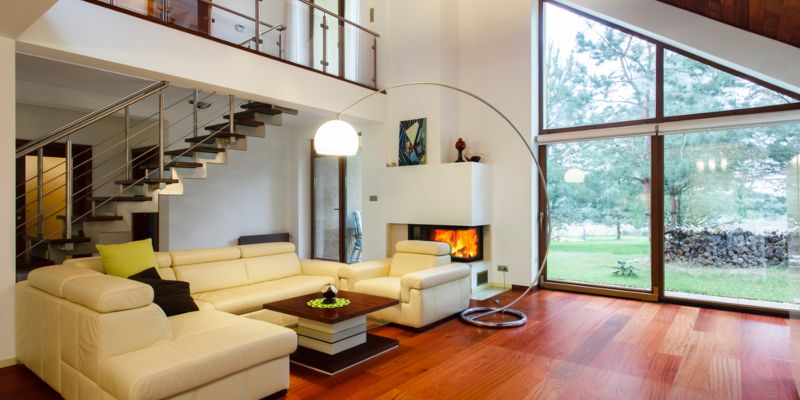
How to select Flooring is a crucial decision when renovating or building a new home. The right flooring can dramatically enhance a room’s aesthetic appeal, boost its value, and even improve its functionality. However, with so many options available—from hardwood to tile, carpet to laminate—it can feel overwhelming to select the optimal flooring for your specific needs. This guide will equip you with the knowledge to select the perfect flooring for each room in your house, ensuring a harmonious and functional living space. We’ll explore various flooring types, discuss their pros and cons, and guide you through a step-by-step process to make an informed decision. Let’s dive into the world of flooring and find the perfect match for your home!
selecting Flooring for High-Traffic Areas
High-traffic areas like entryways, hallways, and living rooms experience considerable foot traffic daily. The flooring in these spaces needs to be durable, easy to clean, and resistant to scratches and stains. Several options excel in these areas:
Hardwood Flooring
Hardwood flooring offers classic elegance and durability. However, certain species, like oak or maple, are more resistant to scratches than others. Regular sealing is recommended to protect against stains and moisture damage. Consider the finish; a satin finish is less prone to showing scratches than a high-gloss finish. While durable, hardwood can be expensive and may require refinishing over time.
Ceramic or Porcelain Tile
Ceramic and porcelain tiles are highly durable and water-resistant, making them ideal for high-traffic areas. Porcelain tile is generally denser and more scratch-resistant than ceramic tile. The grout lines require regular cleaning to prevent staining and mildew. They can feel cold underfoot, so consider using rugs in colder climates.
Related Post : The Best Flooring Choices for Open-Concept Spaces
Laminate Flooring
Laminate flooring presents a budget-friendly, durable alternative to hardwood. It’s relatively easy to install and maintain, and is available in various styles that mimic wood or stone. However, it’s not as durable as hardwood or tile and can be easily scratched or damaged by moisture. Proper installation and sealing are crucial for longevity.
Choosing the right flooring for high-traffic areas requires careful consideration of your lifestyle, budget, and desired aesthetic. A durable floor is an investment that will pay off in the long run, ensuring the longevity and beauty of your home.
Choosing Flooring for Kitchens and Bathrooms
Kitchens and bathrooms present unique challenges due to their exposure to moisture and potential spills. The flooring must be waterproof, easy to clean, and resistant to stains and mold. Here are some excellent choices:
Waterproof Vinyl Plank Flooring
Waterproof vinyl plank flooring has gained immense popularity for its durability, water resistance, and affordability. It mimics the look of wood or tile but offers superior protection against moisture. Vinyl planks are easy to install and clean, and come in a variety of colors and textures. However, it can show scratches and dents over time.
Ceramic or Porcelain Tile
As mentioned earlier, ceramic and porcelain tiles are excellent choices for moisture-prone areas. Their non-porous nature prevents water absorption, making them ideal for kitchens and bathrooms. However, the grout lines require regular cleaning, and the tiles can be cold underfoot.
Natural Stone Flooring
Natural stone like marble or granite adds elegance and sophistication to kitchens and bathrooms. However, it can be quite expensive and requires sealing to protect against staining and moisture damage. It is also more prone to scratching than other materials and requires regular maintenance.
The key considerations for kitchen and bathroom flooring are water resistance, easy maintenance, and durability. Opt for flooring that can withstand spills and withstand everyday wear and tear. Choosing a flooring type that optimal fits your budget and aesthetics is vital too.
optimal Flooring for Bedrooms and Home Offices
Bedrooms and home offices prioritize comfort and a peaceful atmosphere. The flooring should be comfortable underfoot, quiet, and contribute to a relaxing environment. Several options work well in these spaces:
Carpet Flooring
Carpet offers warmth, comfort, and sound insulation, making it ideal for bedrooms and home offices. It’s available in various styles, colors, and textures to suit any design aesthetic. However, carpets require regular cleaning to prevent the accumulation of dirt, dust mites, and allergens. varied carpet fibers offer varying degrees of durability and stain resistance. Regular vacuuming and professional cleaning are crucial for maintaining the carpet’s appearance and lifespan.
Hardwood Flooring
Hardwood flooring’s durability, elegance, and relative ease of maintenance also makes it suitable for bedrooms and home offices. It creates a warm and inviting ambiance, and can be easily cleaned. However, hardwood can be relatively cold underfoot, and the natural wood can be more susceptible to damage than other flooring types.
Laminate Flooring
Laminate flooring offers a more budget-friendly alternative to hardwood while still providing a relatively comfortable and quiet surface. It’s also easy to clean and maintain. However, it’s not as durable as hardwood, and it can be susceptible to scratches and moisture damage. It may not be as comfortable underfoot as carpet flooring.
The primary focus for bedrooms and home offices should be comfort, quietness, and aesthetics. Consider the level of foot traffic and your personal preferences when making your selection.
Flooring Considerations for Basements and Garages
Basements and garages require flooring that can withstand moisture, temperature fluctuations, and potential spills. Durability and easy maintenance are paramount. Here are some suitable choices:
Epoxy Flooring
Epoxy flooring is a highly durable and chemical-resistant option ideal for basements and garages. It’s seamless, easy to clean, and can withstand heavy traffic. However, epoxy flooring can be challenging to install and may require professional help. It is a relatively costly option for many home owners.
Concrete Flooring
Concrete flooring is a classic, budget-friendly option for basements and garages, offering exceptional durability. It’s highly resistant to moisture and can withstand heavy loads. However, untreated concrete is porous and can be prone to staining. Sealing the concrete floor is crucial for protection and longevity.
Vinyl Flooring
Vinyl flooring, in sheet or tile form, is another suitable option for basements and garages. It’s waterproof, relatively inexpensive, and comes in a variety of colors and patterns. However, vinyl flooring can be easily scratched and may not be as durable as epoxy or concrete. It is quite easy to maintain, however.
For basements and garages, durability and moisture resistance are key priorities. select a floor that can withstand potential water damage, spills, and heavy traffic. The flooring’s aesthetic appeal is secondary in these rooms.
Understanding varied Flooring Materials and Their Pros & Cons
Before making a decision, it’s essential to understand the characteristics of varied flooring materials. Each has benefits and disbenefits:
Hardwood Flooring: Pros – Classic look, durable, adds value to home; Cons – Expensive, requires maintenance, susceptible to scratches and water damage
Laminate Flooring: Pros – Affordable, easy to install, water-resistant options available; Cons – Not as durable as hardwood, can be easily scratched
Vinyl Flooring: Pros – Waterproof, affordable, easy to clean; Cons – Can be easily scratched, less durable than other options
Ceramic Tile: Pros – Durable, water-resistant, easy to clean; Cons – Can be cold underfoot, grout lines require regular cleaning
Carpet: Pros – Comfortable, warm, good sound insulation; Cons – Requires regular cleaning, can harbor allergens, not suitable for high-moisture areas
This information should inform your decision, ensuring your selection aligns with your budget, lifestyle, and aesthetic preferences. Matching flooring to function is crucial to a happy home!
Choosing the right flooring is crucial for both the aesthetics and functionality of your home. Remember to consider the room’s function, your lifestyle, and budget when making your selection. By carefully weighing the pros and cons of varied flooring materials, you can create a space that is both beautiful and practical. Still unsure about which flooring is optimal for your needs? Consult with a flooring professional for personalized advice and guidance. Don’t hesitate to explore your options further and find the perfect flooring solution for every room in your house. selecting the right flooring can transform your home!
